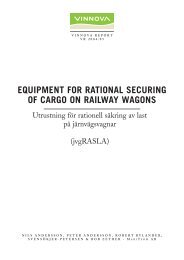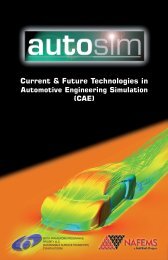WP3: Rail Passenger Transport - TOSCA Project
WP3: Rail Passenger Transport - TOSCA Project
WP3: Rail Passenger Transport - TOSCA Project
You also want an ePaper? Increase the reach of your titles
YUMPU automatically turns print PDFs into web optimized ePapers that Google loves.
Table 5-4a Cost characteristics, aggregated and weighted over intercity, regional and city<br />
trains (electric and diesel), as estimated for new trains by 2050, compared with<br />
reference trains.<br />
Note: In this table energy cost is excluded from operating cost, but is indicated as the expected<br />
amount of energy consumption per passenger-km (pkm)<br />
Sales price<br />
(MEUR / train<br />
unit)<br />
Varia<br />
Estimated<br />
-tion<br />
Operating cost d<br />
(EUR / pass-km)<br />
Estimated<br />
Variation<br />
Energy e<br />
(MJ<br />
/pkm)<br />
Most<br />
likely<br />
Reference electric trains (2009) a 15.1 ±2 0.098 ±0.011 0.368<br />
1. PA Low drag b 15.4 ±2 0.099 b ±0.012 0.334<br />
2. PB Low mass 16.5 ±2.5 0.099 ±0.014 0.343<br />
3. PC Energy recovery 15.1 ±2 0.096 ±0.012 0.313<br />
4. PD Space efficiency 12.7 c ±2 0.089 ±0.012 0.314<br />
5. PF Eco-driving 15.2 ±2 0.097 ±0.011 0.310<br />
6. Pcomb electric + incremental 14.6 c ±2.5 0.088 ±0.015 0.157<br />
7. Pcomb HS (6) + higher speed 16.5 c ±2.8 0.087 ±0.016 0.187<br />
Reference diesel train (2009) a 12 ±1.5 0.127 ±0.014 0.75<br />
9. Pcomb diesel + incremental 12 ±1.5 0.120 ±0.014 0.37<br />
a<br />
At the reference year electric trains have a total estimated market share of 88 %, and diesel-hauled trains 12 %.<br />
b For high-speed trains it is assumed that a ‘Low-drag’ train will have 3 % less number seats due to longer front<br />
and tail. Other types of trains will not be influenced in this respect.<br />
c Sales price recalculated for the equivalent number of seats as for the reference of 2009. See note c) of Table 5-2.<br />
d Operating costs include capital, maintenance, crew, track & station & dispatch, train formation, sales and<br />
administration. Capital cost excludes profit margins.<br />
e Energy intake to railway’s electric supply system or to fuel tank.<br />
At the reference year 2009, the average cost of electric energy in EU-27 (taken from power grid) is<br />
0.091 EUR /kWh or 0.025 EUR /MJ. For diesel fuel the average cost is 0.015 EUR/MJ.<br />
In both cases taxes are excluded.<br />
Note that the difference in sales price per train unit, as a result of changes in technology, in<br />
most cases is smaller than the normal variation of sales price between different suppliers and<br />
depending on the actual market situation. The estimates should therefore be interpreted as<br />
average prices. Average prices are assumed to follow cost variations, on the assumption that<br />
supplier‘s profit margins will not be changed.<br />
Despite the relatively small variations in sales prices of trains with different energy-saving<br />
technologies, it is anticipated that even these differences must be justified at train acquisition.<br />
Even moderate price differences will be valued in relation to the documented or believed<br />
benefits they offer.<br />
Deliverable D4 – <strong>WP3</strong> passenger 25
















